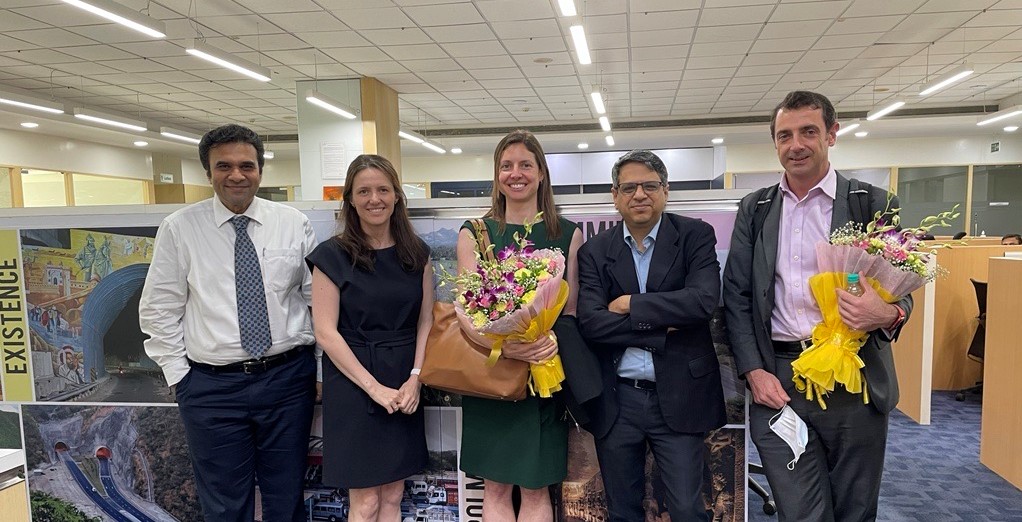OMERS Infrastructure began its journey in India approximately five years ago. Today we have investments in two companies: road company Indinfravit and energy transition firm Azure Power. In any country, it is important to spend time understanding the landscape, building relationships and identifying investable trends. We have significant ambition to grow our investment in India and so naturally, we were excited to plan a first post-COVID visit.
It was an incredible week, with 20 meetings, including time in both Delhi and Mumbai. We met with investment partners, key banking relationships, government ministries, and potential investment opportunities and partners. Most importantly we spent time with the leadership teams at our two portfolio companies.
After reflecting on all that we heard and discussed over the course of the week, we have six important takeaways we believe are shaping the infrastructure opportunity in India.
Private capital in infrastructure: We view private capital as an integral part of the solution for funding India’s infrastructure needs. It should be embraced versus avoided, and there is no debate – it simply is. This shouldn’t be taken for granted, and is part of what makes it such an attractive geography for investors. The government has very ambitious plans, for example 450GW of new renewables by 2030 and 27,000 km of road to be privatized by 2025, both leading to multi billions of dollars of potential opportunity.
Demographics: India’s growing middle class could be the world’s largest by 2025. The power of this to shape consumer culture – and the infrastructure required to serve it – is immense. Approximately two-thirds of India’s 1.4 billion population still live outside major urban city centres. We expect this to change. The investment in infrastructure needed to support a rural to urban shift is massive, and while the government is hoping to assuage the impact by building new hubs, the need for cities to accommodate more people will have significant impact.
GDP growth: India is one of the fastest growing economies in the world, fuelled by strong fundamentals and growth-enhancing policies. The emphasis on manufacturing in India, the digitization and technology transformation drive, and the increased infrastructure spending are some of the trends we’ve observed that give the infrastructure sector a strong tailwind. There is a need to build power generation capacity and power lines to meet the growing electricity demand; telecom towers, fiber networks and data centers to meet the digitalisation drive; roads, airports and ports to transport a growing population and middle class, and an increasing freight volume.
Evolving governance: We heard about the focus on good governance and progress being made in India. Companies recognize the importance of maintaining strong governance practices, and that this should be rewarded with higher returns. The drive to make improvements is to help attract more foreign capital, and consistent with the core values of many leaders in the country who appear to be making it a priority.
Value in the value chain: There are several strong group organizations, or conglomerates, that approach investing in a way that captures value across the value chain in a way that we believe is somewhat unique to India. Elsewhere, investors tend to acquire interests in a series of companies that are a part of the infrastructure sector. In India organizations are not just focused on a single asset class, but are in some cases building whole sectors, capturing all the value that might otherwise be lost moving across a value chain or multiple asset classes.
Technology: Infrastructure has been slower to adopt technology and digitally transform than other industries. Perhaps with the significant capabilities in India, supplying much of the world’s technical workforce, India will precipitate accelerated adoption. In fact, we believe India is already providing infrastructure investors opportunities in sought-after digital infrastructure sectors.
The visit emphasized the incredible opportunity for infrastructure in India and we are excited to continue our journey leading change and building value.
The views expressed in this article are not to be taken as advice or a recommendation to buy or sell any investment in any jurisdiction. Any information or opinions are provided for informational purposes only, and are subject to change without notice. Neither OMERS nor OMERS Infrastructure nor any of their affiliates makes any representation or warranty, express or implied, as to the accuracy, reliability or completeness of any information contained in this article, and any liability therefore is expressly disclaimed. OMERS Infrastructure is not providing any financial, economic, legal, accounting or tax advice or recommendations in this article.



